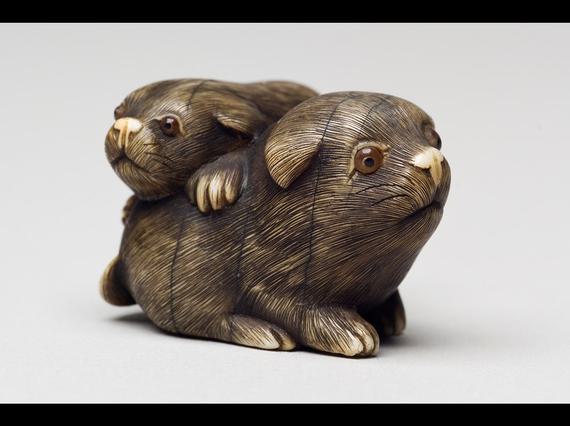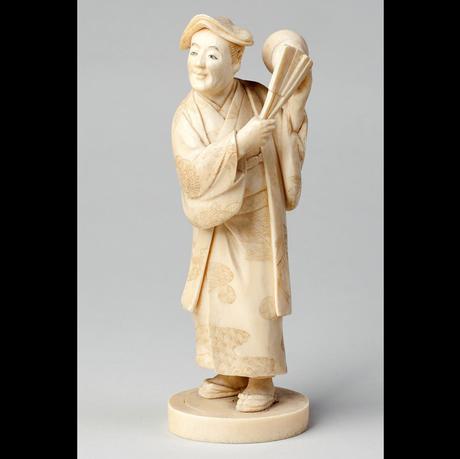
East Asia in North East Scotland
Find out more about East Asian collections in Aberdeen, Aberdeenshire and Moray.
Aberdeen
Aberdeen Art Gallery & Museums, Aberdeen City Council
Aberdeen Art Gallery and Museums' collection contains more than 250 Chinese artworks dating from the 7th Century to the 20th Century. Highlights include cloisonné enamel vessels, lacquer ware and porcelain.
Image gallery
Born in Aberdeen, James Cromar Watt (1862-1940) was an architect, enamellist and jeweller who amassed a vast collection of decorative art from overseas including Chinese lacquer ware, metalwork, ceramics, carvings and textiles. After his death, many of these objects were bequeathed to Aberdeen City Council. His bequest amounts to almost half of the Chinese decorative art collection.
There are also more than 60 Japanese objects dating from the 18th century to the 21st century including metalwork and ceramics. Intricately carved netsuke and okimono are particular highlights.
University of Aberdeen
There are around 600 artefacts from China, Japan and Korea in the collections at the University of Aberdeen. This total excludes the 9,000 coins from India, China and the rest of Asia dating from 220 BCE to the 20th century, that were not surveyed by National Museums Scotland. The University estimates that there are 800 Chinese and 50 Japanese coins in the collections, bringing the total number of East Asian artefacts to 1,500 items.
The scope of the Chinese collection is extensive and includes military items, textiles, dress and accessories, photographs, figurines, Tang-dynasty (618-906) ceramics, archaic bronzes, musical instruments, ceremonial objects, carved ivory ornaments, articles relating to calligraphy. The Tibetan items include prayers, prayer wheels, amulet boxes, bowls, censers and candlesticks. Within the Japanese collections, there are arms and armour, Buddhist icons and ceremonial objects, mirrors, scroll paintings, woodblock prints, textiles, dress and accessories, musical instruments, Ainu-related objects, paper-leather samples and fans.
Some of the East Asian objects were given to the University by alumni who had travelled or lived overseas. Others were bought at auctions in the 1960s and 1970s by a curator purposefully building up a decorative art collection. The generous donations and bequests of this collection are joined by purchases made by a former honorary curator of the museum, Professor Robert Lockhart (1942-1979).
Aberdeenshire
Live Life Aberdeenshire Museums
Many of the East Asian objects at Live Life Aberdeenshire Museums are Chinese and date from the 18th and 19th centuries. Highlights include a wooden D-shaped pillow, a bamboo crossbow, diancui jewellery, carved ivory, and a geomancer’s compass to advise on the most auspicious direction for constructing new buildings and conducting burials. The Japanese items largely date from World War 2 (1941-1945) including swords and numismatics.
Moray
Elgin Museum
The main donors to Elgin Museum were Mrs Therese Sophie Levack who donated 93 items from the collection of her mother in law, Mrs Janet Taylor Levack (née Brander; 1842-1927) who was married to Captain John Levack (1833-1887). Captain Levack, a shipmaster and mercantile marine, commanded a ship of the Shaw Saville Line, one of the first to enter a treaty port after Japan ended its trade isolation in 1859. When sailing ships were overtaken by steamers he became part owner of a vessel sailing to New Zealand, Australia and East Asia accompanied by his wife, Janet Taylor Brander. The Levack collection comprises Chinese export ceramics, carved ivories, and textiles, in addition to Japanese cloisonné and ceramics.
A highlight of the collection is a rare embroidered neckpiece with carved bone ornaments, which would have been worn by a high-status practitioner of Tibetan Buddhism. The neckpiece entered the collection in 1866, and was presented by Major M J Brander.
Falconer Museum, Moray Council
The collection of East Asian materials at Falconer Museum were donated by Miss Constance Frederica Gordon-Cumming (1837-1924) and Mr Hugh Mackenzie. The collection has Japanese newspapers, crepe woodblock prints, and East Asian instruments from Mackenzie, and a small group of items that Gordon-Cumming collected while traveling in Japan and China (1878-1879).


